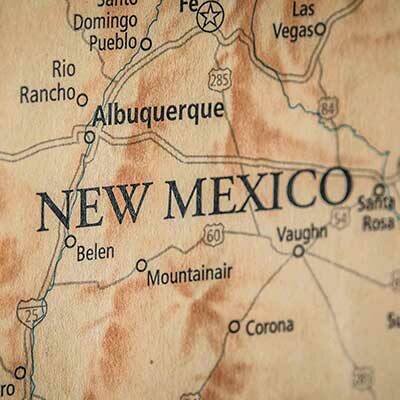‘Forever chemicals’ found at Los Alamos
Laura Paskus
April 26, 2021
Please read our latest story for the most accurate information.
After NMPBS published this report in February 2021—based on data from Intellus New Mexico, which provides environmental monitoring data from Los Alamos National Laboratory—lab officials admitted they had mischaracterized the samples with high levels of PFAS in their database. Those samples, which LANL officials said were from “storage vessels” of Aqueous Film Forming Foam, formed the basis for this story, as originally published.
NMPBS is committed to providing accurate journalism. That said, we also realize that nothing truly disappears on the Internet. That's why we've left this page active, while also rewriting portions of it to avoid the persistence of misinformation.
Frankly, this was a frustrating process for us as we reported out the best available information. When NMPBS contacted state regulators about high levels of PFAS present in the environment, they were relying on data from Intellus, too. While lab officials eventually granted an on-the-record interview to bring the truth about their error to light, they initially demanded a retraction without providing any evidence that something was wrong. Given the history of secrecy at LANL, NMPBS insisted upon an on-the-record conversation to better understand what happened. It remains our firm belief that this situation could have been avoided had communications staff at Los Alamos and the U.S. Department of Energy been willing to talk and offered more than a boilerplate response to our initial inquiry.
Finally, if you have questions, tips, thoughts or concerns generated by what you've read, please let us know. We want to hear from you.
For nearly eight decades, Los Alamos National Laboratory has contaminated waters and soils with myriad hazardous chemicals and radioactive waste. Now, testing by scientists around the mesa-top nuclear weapons lab reveals widespread—and in some instances, extremely high—levels of PFAS, or per- and polyfluoroalkyl substances.
Most of the samples they collected revealed just traces of various members of the PFAS family, including perfluorooctanesulfonic acid (PFOS) and perfluorooctanoic acid (PFOA). But some water samples ranged from 4,130 parts per trillion to 4,290,000 parts per trillion.
That’s 60 to 60,000 times the recommended lifetime exposure limit.
The New Mexico Environment Department (NMED) is aware of the presence of PFAS in water samples. Officials don’t believe there is an immediate threat to human health but told NMPBS they do need more information.
Speaking via Zoom along with three of the agency’s scientists who work on PFAS issues, NMED Secretary James Kenney said they’ve been asking themselves, “What happens next?”
“We have to make a decision based on the risk we see in the data: Do we pull resources from other parts of New Mexico and manage this? Or do we say that this risk is not as significant as risk in other places, so we’re going to continue to manage those other sites?” he asked. “These are the decisions that the Environment Department is having to make, which we should never have to make for the citizens of New Mexico.”
The PFAS family of toxic, human-made chemicals are called “forever chemicals” because they don’t break down under natural processes like exposure to sunlight or microbes. They also bioaccumulate, lodging themselves in one body after another as they move up the food chain.
The United States lacks a federal regulatory limit for PFAS. But the U.S. Environmental Protection Agency has set a lifetime health advisory for exposure to PFOS and PFOA—just two of the thousands of types of PFAS—at 70 parts per trillion.
Exposure to PFAS have been linked to reproductive and developmental problems, liver and kidney disease, and immune system problems. It's also been tied to high cholesterol, low infant birth weights, thyroid hormone disruption, early-pregnancy miscarriages, and cancer—including non-Hodgkin’s lymphoma and kidney, testicular, prostate, and ovarian cancers.
According to NMPBS’s search of the Intellus database, which compiles environmental monitoring information about Los Alamos, PFAS was found in samples from groundwater, wastewater effluent, and wastewater treatment plants. Water from the various treatment plants is released into canyons including Sandia Canyon, Pueblo Canyon, Mortandad Canyon, Cañon de Valle, and Los Alamos Canyon.
Recent testing for PFAS is part of a larger effort to monitor thousands of types of contaminants in the waters, soils, and air around Los Alamos. The PFAS is likely from Cold War-era work done at the lab, said Chris Catechis, NMED’s acting Department of Energy Oversight Bureau Chief.
“We’re well aware that groundwater is most peoples’ [source for] drinking water in New Mexico and we’re well aware of where Los Alamos is situated,” said Kenney, referring to the lab’s location upstream of pueblos as well as the water supplies for Los Alamos, Santa Fe, and Albuquerque.
NMPBS asked the lab for an interview and additional information. A U.S. Department of Energy spokesperson responded via email that the agency “has been conducting extensive sampling at LANL to determine the presence of these chemicals.” Further, according to the statement: “Our study of these chemicals is ongoing. As we learn more, we will share information with regulators and stakeholders as we develop plans to identify, track and mitigate these substances following regulatory requirements.”
‘We want them to do the right thing’
NMED has been grappling with what to do about PFAS pollution since 2018, when the Air Force notified state officials that PFAS from firefighting foams had contaminated groundwater below Cannon and Holloman Air Force bases.
At that time, the state issued a Notice of Violation against the military, but the Air Forced sued the state, challenging its authority.
New Mexico then filed its own lawsuit, asking a federal judge to compel the military to act on and fund cleanup of the toxic plumes. In 2019, the federal court system moved the state’s case against the military to multidistrict litigation in South Carolina, where one court is overseeing more than 750 separate cases related to PFAS. The state wants its case moved out of that court and remanded back to New Mexico.
In the intervening years, the Air Force has not shared a cleanup plan or begun any remediation. Last year, the New Mexico Legislature allocated funding for some studies to understand where the plumes are moving, and which wells have been tainted.
One sticking point in the military’s dispute with NMED involves the lack of federal regulations for PFAS, without which NMED can’t legally compel polluters to clean contaminated water to a particular standard. Under the Trump administration, the EPA lagged in implementing its “PFAS Action Plan,” which included considering regulatory standards for PFOA and PFOS and initiating health assessments for some other types of PFAS.
But state officials also blame a lack of resources.
Kenney has repeatedly pressed legislators over funding for NMED, as the agency is still trying to bolster its budget after the Legislature and Gov. Susana Martinez cut agency funding by roughly 30 percent between fiscal years 2012 and 2019.
He also acknowledged that the agency may encounter resistance from the U.S. Department of Energy and Los Alamos National Lab, as it has from the U.S. Department of Defense.
“We want them to do the right thing here, and if the right thing is beginning remediation—whether you know what the standard should be or not—you can begin,” he said. The state shouldn’t have to file lawsuits to get the federal government to clean up its pollution, he said.
Federal costs and benefits
Although the federal government is one of the state’s largest employers, it’s also one of the biggest sources of pollution in New Mexico. “We spend significantly more of our resources holding the federal government accountable [for environmental pollution] than we do small- and middle-sized businesses,” Kenney said.
Oftentimes, he said, these agencies have “admirable” missions focused on public service. They should also be good stewards—especially given their considerable budgets.
The estimated Fiscal Year 2021 budget for Los Alamos was $3.39 billion. Seventy percent of that goes toward nuclear weapons programs, while one percent is allocated to environmental management. That’s about $33 million, half of which is allocated toward work at the Waste Isolation Pilot Plant near Carlsbad. According to the lab, an additional DOE contract for $226 million is for cleaning up legacy pollution at Los Alamos.
NMED’s budget request from the Legislature for Fiscal Year 2022 is $89.2 million.
“We will continue to muster up whatever resources we can to continue to look at this issue, but that means we’re disinvesting somewhere else in the state, or we have another high priority in the state that we’re not looking at,” said Kenney, adding: “We are not funded to address all the environmental problems in the state of New Mexico.”
On Thursday, NMED will host its quarterly Los Alamos community engagement meeting.
This story has been updated. The original version stated that LANL's FY2021 spending on environmental cleanup was $33 million, according to the lab's budget breakdown on its website. Based on additional information provided by the lab following publication, NMPBS changed the number to reflect spending under an additional DOE contract. According to the lab, DOE's total FY2021 spending on environmental management at LANL is approximately $243 million.
If you’ve been affected by PFAS contamination in your community here in New Mexico, call our tip line at (505) 433-7242. To read more coverage of PFAS in New Mexico visit “Groundwater War: New Mexico’s Toxic Threat,” which includes a timeline of events and studies on PFAS.







[…] the full article by Laura Paskus (New Mexico […]
[…] week, I reported that PFAS, or per- and polyfluoroalkyl substances, had been found in water samples collected at Los […]
[…] original compound, and now a site for both military and civilian research – has contended with groundwater pollution, workplace hazards related to the toxic metal beryllium, and gaps in emergency planning and worker […]
[…] original compound, and now a site for both military and civilian research—has contended with groundwater pollution, workplace hazards related to the toxic metal beryllium, and gaps in emergency planning and worker […]
[…] original compound, and now a site for both military and civilian research – has contended with groundwater pollution, workplace hazards related to the toxic metal beryllium, and gaps in emergency planning and worker […]
[…] original compound, and now a site for both military and civilian research – has contended with groundwater pollution, workplace hazards related to the toxic metal beryllium, and gaps in emergency planning and worker […]
[…] compound, and now a site for both military and civilian research – has contended with groundwater pollution, workplace hazards related to the toxic metal beryllium, and gaps in emergency planning […]
[…] original compound, and now a site for both military and civilian research – has contended with groundwater pollution, workplace hazards related to the toxic metal beryllium, and gaps in emergency planning […]
[…] original compound, and now a site for both military and civilian research – has contended with groundwater pollution, workplace hazards related to the toxic metal beryllium, and gaps in emergency planning and worker […]
[…] original compound, and now a site for both military and civilian research – has contended with groundwater pollution, workplace hazards related to the toxic metal beryllium, and gaps in emergency planning and worker […]
[…] original compound, and now a site for both military and civilian research – has contended with groundwater pollution, workplace hazards related to the toxic metal beryllium, and gaps in emergency planning […]